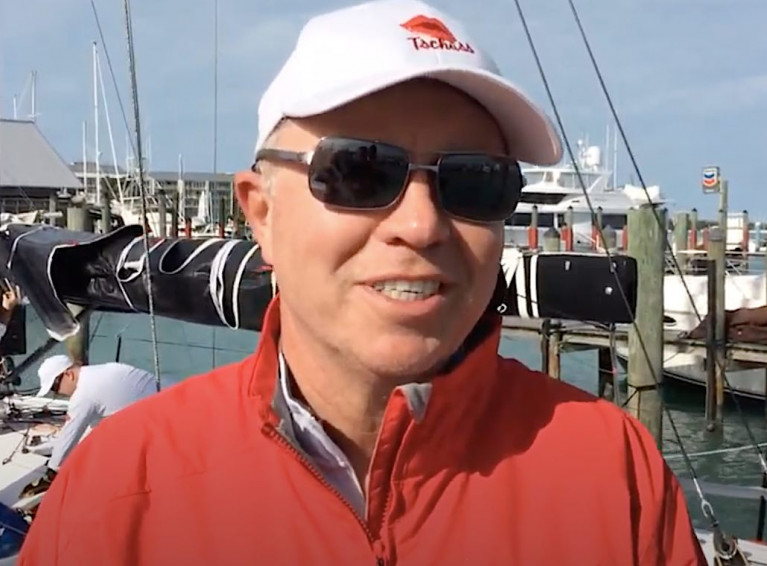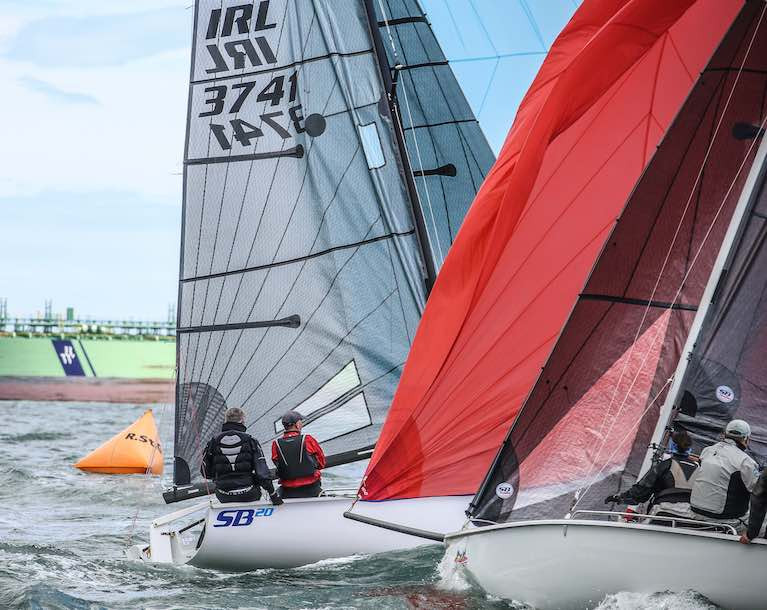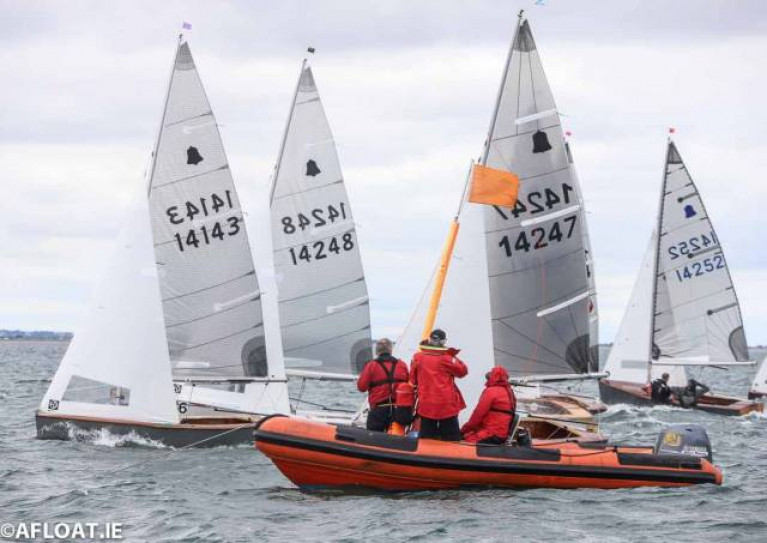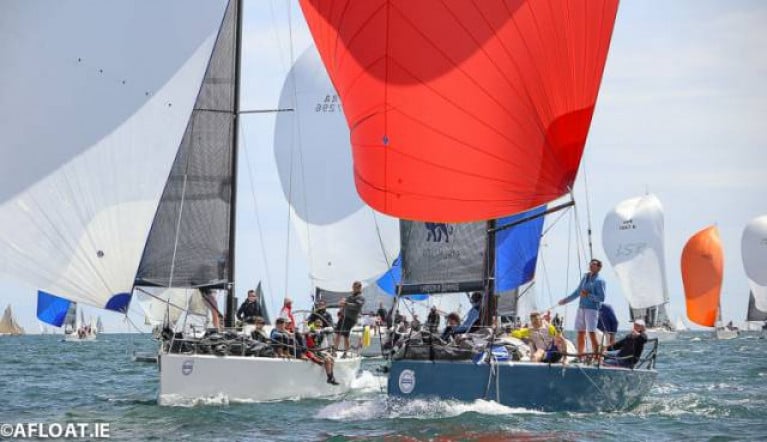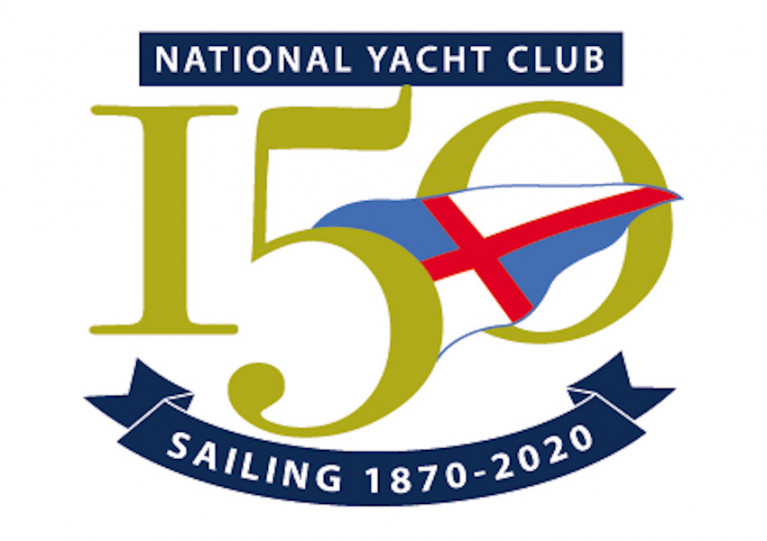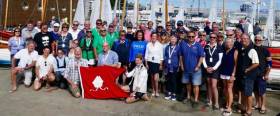Displaying items by tag: Dun Laoghaire Regatta
Big Surge in Entries Brings Volvo Dun Laoghaire Regatta Close to 300; Early Bird Entry Now Extended to April 16
July's Volvo Dun Laoghaire Regatta on Dublin Bay saw a big surge in early bird entries the last few days of March with the fleet now close to 300 of the expected 400 boats which, organisers say, will really help in planning for the biennial event.
The Wayfarer dinghy class were added to the running order yesterday bringing adding another ten boats to VDLR 2021.
As regular Afloat readers will know, in order to facilitate social distancing and be Covid-19 compliant, a new regatta format will comprise a One Design Championship (2nd – 4th July 2021) specifically tailored for sailors in the one-design keelboat and dinghy classes. This is to be followed by an Open Cruiser Championship (8th – 11th July 2021) catering for the full range of Cruiser Handicap classes.
In anticipation of a summer outside of 5km bubbles that might just be possible, the VDLR committee is extending the current Early Bird Entry price until Friday 16th April 2021.
 The entries so far for July's VDLR 2021 on Dublin Bay
The entries so far for July's VDLR 2021 on Dublin Bay
Event Chairman, Don O'Dowd told Afloat: "We saw a surge of entries in the final 24 hours of March, and look forward to seeing everyone on the water as soon as it is safe to do so".
"Thanks to those 260 who have already entered across both weekends. It is great to see a number of the classes now taking shape and will really assist in the logistics and planning for this year's regatta", he added.
The safety of participants and volunteers is of the utmost importance to the Waterfront Clubs and the Organising Committee of the Volvo Dun Laoghaire Regatta 2021. We are working extremely hard to ensure a Covid-19 compliant Regatta shall be run over the two weekends in July. The Regatta will comply with all current Government Guidelines relevant at that point in time, Event Chairman, O'Dowd said.
Ruffian 23s To Race for National Title as Part of Volvo Dun Laoghaire Regatta One Design Weekend
The Ruffian 23 National Championships has been confirmed for July's Volvo Dun Laoghaire Regatta National Championships on Dublin Bay.
An expected entry of 15 boats will contest the title as part of the new format One Design weekend for VDLR 2021 from July (2nd – 4th July 2021) specifically tailored for sailors in the one-design keelboat and dinghy classes.
The quarter-ton class which celebrated its 48th birthday this season is expected to see Ruffians from Skerries, Greystones & Wicklow and possibly Carrickfergus in Northern Ireland and Poolbeg compete.
The class has its biggest fleet on Dublin Bay with 15 registered with Dublin Bay Sailing Club, where club commodore Ann Kirwan is a stalwart.
The 2019 champion is Belfast Lough Ruffian 23 Carrageen (Trevor Kirkpatrick) from Carrickfergus.
Second Ker 40 for Volvo Dun Laoghaire Regatta's Offshore Class
A second UK-based Ker 40 will race in July's Volvo Dun Laoghaire Regatta's Offshore class adding extra spice to Ireland's biggest IRC regatta of the year.
Today's entry of US-based German skipper Christian Zugel's 'Tschuss' sailing under the burgee of New York Yacht Club and Royal Cork Yacht Club will line up with Niall Dowling’s Ker 40 Arabella that is also joining the VDLR offshore fray for the first time. London based Dowling took both line honours and the overall win in Wicklow’s Round Ireland Race in 2018 with the bigger Ker 43 Baraka GP and is set to be back on Irish waters next July 8.
Though Tschuss (ex Invictus) hasn't competed in Dublin before, the 2017-built racer was slated for 2020's cancelled Cork Week Regatta, she is no stranger to Irish sailing having competed at a previous Sovereigns Cup in Kinsale, She had Irish crew onboard for a 2017 Cowes Week campaign as Afloat reported here. 2017 Pit boss Johnny Mordant is involved in the 2021 campaign that will see it make its Dublin Bay debut.
The Ker 40 a top-end race boat has the capacity to race across a wider range of racing categories and for this season more and more owners thoughts are turning to what type of racing is feasible under COVID and as Afloat has reported previously there is a move to offshore and coastal racing
The Ker line-up for Dun Laoghaire means defending champion Seamus Fitzpatrick in the First 50, Mermaid will have his work cut out to repeat the performance IRC offshore class. Fitzpatrick is already entered as Afloat reported previously here.
Here's a vid of the German Skipper talking about Key West Regatta in 2016.
Dinghy, One Design & Cruiser Class Championships Sign Up for Volvo Dun Laoghaire Regatta 2021
Preparations for Volvo Dun Laoghaire Regatta 2021 next July on Dublin Bay are off to a flying start with nine of the expected 22 racing classes already declaring regional or national championships to be held as part of the biennial sailing festival.
It has been confirmed that Dragons will race for national honours and so will Beneteau 211s, Beneteau 31.7s and Shipmans.
As regular Afloat readers will know, in order to facilitate social distancing and be Covid-19 compliant, a new regatta format will comprise a One Design Championship (2nd – 4th July 2021) specifically tailored for sailors in the one-design keelboat and dinghy classes. This is to be followed by an Open Cruiser Championship (8th – 11th July 2021) catering for the full range of Cruiser Handicap classes.
 The Dublin Bay-based Shipman keelboat class will sail for national championship honours as part of Volvo Dun Laoghaire Regatta 2021 Photo: Afloat
The Dublin Bay-based Shipman keelboat class will sail for national championship honours as part of Volvo Dun Laoghaire Regatta 2021 Photo: Afloat
The special changes, announced in September, have been met with a strong seal of approval from competitors with the following early adopters:
- Beneteau 211 National Championships
- Beneteau 31.7 – National Championships
- Shipman – National Championships
- GP14 – Leinster Championships
- Fireball Leinster Championships
- Dragon – Irish National Championship
- SB20 Western Championships
- RS200 Leinster Championships
- RS400 Leinster Championship
 The Beneteau 211s will also race for National Championship honours Photo: Afloat
The Beneteau 211s will also race for National Championship honours Photo: Afloat
Royal Dee ISORA Championships
In addition, in the cruiser classes, the Royal Dee Irish Sea Offshore Championship will be held as part of VDLR 2021. These offshore races will be held together with the Lyver Trophy Race from Liverpool to Dun Laoghaire on Friday 1st July 2021, to make it a highlight of next year's Irish Sea Offshore (ISORA) season.
 ISORA racing will be incorporated into Volvo Dun Laoghaire Regatta 2021
ISORA racing will be incorporated into Volvo Dun Laoghaire Regatta 2021
It's a satisfying early result for the VDLR Committee under Chairman Don O'Dowd who meets again with his committee tonight to finalise the Notice of Race document due for release shortly.
Meeting the COVID-19 challenges in 2021
Dun Laoghaire is unique in being able operate in this pandemic because of the extensive area within the harbour site and facilities provided by the waterfront clubs and organisations. The Regatta will utilise the full infrastructure of Dun Laoghaire Harbour venue to the best advantage and bring certainty to a calendar that has been hugely dictated by Covid-19 and the constraints imposed due to social distancing.
GP14s Give Thumbs up to Volvo Dun Laoghaire Regatta 2021 Dinghy Plans
The Irish GP14 dinghy class has been one of the first to give a thumbs up to Volvo Dun Laoghaire Regatta plans for next July to divide Ireland's biggest sailing event over separate weekends.
As Afloat reported previously, Dun Laoghaire organisers plan to major on the dinghies and one design keelboats with a One Design Championship from 2nd – 4th July 2021 and then run the cruiser-racers the following weekend (8th – 11th July) catering for a full range of IRC classes.
After a year of cancellations that wiped out nearly the entire GP14 2020 calendar, including the Skerries-based World Championships in August, the GP14 Committee has been supportive of Dun Laoghaire's move to the Dinghy/One Design event.
If all goes to plan the Geeps will be just one of many dinghy classes racing at VDLR next July before the restaging of its own class world championships in Skerries later that same month (July 25 to Aug 1 2021).
The only Irish GP14 event to sail so far this year was held in Blessington earlier this month as Afloat reported here.
The committee says there is still hope, notwithstanding the Dublin and Donegal Level 3 lockdowns, that the annual 'Hot Toddy' event can still go ahead in East Antrim in Larne on October 10th.
Volvo Dun Laoghaire Regatta 2021 Announces Format Changes for July Event on Dublin Bay
Dun Laoghaire Harbour's combined waterfront yachts clubs have announced the continued title sponsorship by Volvo Car Ireland of next July's Dun Laoghaire Regatta and a new format for Ireland's top sailing event.
In order to facilitate social distancing and be Covid-19 compliant a new regatta format will comprise a One Design Championship (2nd – 4th July 2021) specifically tailored for sailors in the one-design keelboat and dinghy classes. This to be followed by an Open Cruiser Championship (8th – 11th July 2021) catering for the full range of Cruiser Handicap classes.
'The sponsorship announcement coupled with the significant format changes to VDLR 2021, will give sailors, sponsors, classes and the four waterfront clubs certainty in planning ahead for the 2021 season', says chairman of the organisers, Don O'Dowd.
Volvo Car Ireland has been the title sponsor of Ireland's largest sailing event since 2007 and is again joined by Spirit Motor Group, the premier dealership for Volvo.

Background to the event
Growing over the last 16 years, the regatta is now proudly one of Northern Europe's greatest shows on the water, eclipsed only by the UK's Cowes Regatta, one of the longest-running regular regattas in the world.
Since it first set sail in 2005, Dun Laoghaire Regatta has grown biennially and showcases the very best of Irish sailing action on the water. A regatta of this size also brings a lot of shoreside summer colour and significant economic benefit to the town of Dun Laoghaire.
The last edition in 2019 comprised over 300 sailing races across 30 classes, and 2,500 competitors ranging from Olympic and world-class professionals to weekend sailors drawn from both across Ireland and overseas.
Meeting the COVID-19 challenges in 2021
Dun Laoghaire is unique in being able operate in this pandemic because of the extensive area within the harbour site and facilities provided by the waterfront clubs and organisations. The Regatta will utilise the full infrastructure of Dun Laoghaire Harbour venue to the best advantage and bring certainty to a calendar that has been hugely dictated by Covid-19 and the constraints imposed due to social distancing.
Format Changes planned for 2021
The focus of the new format will be to provide Regatta Sailing of the highest standard - taking advantage of the extensive shoreside facilities for the après sail enjoyment of the local and visiting sailors.
The new format Volvo Dun Laoghaire Regatta will comprise a One Design Championship (2nd – 4th July 2021) specifically tailored for sailors in the one design keelboat and dinghy classes. This to be followed by an Open Cruiser Championship (8th – 11th July 2021) catering for the full range of Cruiser Handicap classes.
The Regatta will provide competitive sailing, fun ashore and offer classes an exciting opportunity around which to plan their championships for 2021.
"Volvo Car Ireland, together with our retail partner, Spirit Motor Group are very proud to continue our relationship with the Volvo Dun Laoghaire Regatta in 2021. Together with Spirit Motor Group we work to support what we see as important events in the community where our customers live, work and engage in sporting activities as an important part of life. Sailing is a sport Volvo support at a community and international level.
The Volvo Dun Laoghaire Regatta has grown to become the largest sailing regatta in Ireland and we are proud to be part of that team and to continue to be associated with the event", David Thomas, Managing Director, Volvo Car Ireland Ltd
"In these most trying and uncharted times, it is truly wonderful to have Volvo Car Ireland back on board for 2021. The VDLR regatta is now in its 9th edition over 16 years and Volvo's participation has been a key to its success. In light of Covid-19 and the possible constraints it will place on the event, we are currently working on a new format for the regatta which will see one-design classes racing on one weekend (2nd – 4th July) and keelboats the following weekend (8th – 11th July). Dun Laoghaire and its unique four waterfront clubs lends itself to facilitating social distancing and being Covid-19 compliant. It is this uniqueness that allows us plan for, what hopefully will be, another very successful Volvo Dun Laoghaire Regatta" Don O'Dowd, VDLR Chairman
The National Yacht Club’s planned two-day race weekend for its own 150th anniversary has been scaled down to a single-day event now known as the Sesquicentennial Race Day.
The decision was reached earlier this week following the latest Government announcements concerning the coronavirus pandemic.
Now scheduled solely on Saturday 5 September, the event will be on-the-water only with no social events or catering on land other than regular offerings available to club members by prior booking.
The NYC website has further details of the reconfigured event and how to enter.
Elsewhere, Wicklow Sailing Club has offered its apologies to the catamarans that were expected to visit the club next weekend as due to the current restrictions, the club is not in a position to host visiting boats.
The East Coast club, which last month was forced to cancel this year’s edition of the Round Ireland Yacht Race, says it hopes to welcome the catamarans again in 2021.
The Notice of Race and entry form are now available for next month’s Dun Laoghaire Regatta, celebrating the National Yacht Club’s 150th anniversary.
This special event, an initiative of all five Dun Laoghaire waterfront clubs, will take place over the weekend of 5-6 September and comprises the Rationel J80 National Championships and Shipman National Championships, as well as the respective Eastern Championships for the SB20 and 29er classes.
The Notice of Race is available to download below, and entry is online via the NYC website HERE.
Happy Hundredth Birthday, Treardur Bay Sailing Club
It’s exactly a hundred years to the day from the establishment of the thriving Treardur Bay Sailing Club at its rocky cove in west Anglesey in North Wales on August 23rd 1919 writes W M Nixon. Back then, the world was only beginning its struggle to recover from the full horror of the Great War of 1914-1918, and events like the formation of a new sailing club were vital to assist the proper return to normal life.
Thus we extend our warmest good wishes across the Channel to a keen group of sailors who brought two boat classes – the Myth 14ft dinghy class founded in 1920, and the Seabird Half Raters from 1898 – to be a much-appreciated presence at the Volvo Dun Laoghaire Regatta 2019 in July, and we wish them well as they launch into their second century tonight.
 Vintage boats in Dublin Bay – at the VDLR 2019 are Treardur Bay Seabirds (1898), Howth 17s with jackyard topsails (1898), and Dublin Bay Mermaids (1932)
Vintage boats in Dublin Bay – at the VDLR 2019 are Treardur Bay Seabirds (1898), Howth 17s with jackyard topsails (1898), and Dublin Bay Mermaids (1932)
And if you wonder what it’s like to sail from a southwest-facing rocky cove on the Welsh coast protected only by reefs, rocks and islets, then this vid from 2018 gives some idea of what sailing can be like when the wind eases a bit after a period of heavy onshore weather at Treardur Bay. The red sails are on the Myths from 1920, and there’s a glimpse of the historic Seabirds out at sea beyond the rocks.
Howth Yacht Club's 'Bite the Bullet' Leads Dun Laoghaire Regatta White Sail Division One
In the IRC Non-spin 1 division of Volvo Dun Laoghaire Regatta today, the Elan 333s are having a fine old time of it, with the overall placings now putting Colm Bermingham’s Bite the Bullet from Howth first, while Paul Tully’s White Lotus (DM) is third, but in between is Terry Fair from Balyholme YC with his Sigma 33 Cariad.
IRC Non-Spinnaker 2
In the IRC Non Spin 2 class, Paul Conway’s stylish veteran Contessa 32 Cevantes revelled in it today to log more wins in every race, next best was the UFO 31 Menapia (James & Sue McSweeney), whole the Holland-designed Super Seal Gung-Ho (Grainnne & Sean O’Shea) was third.
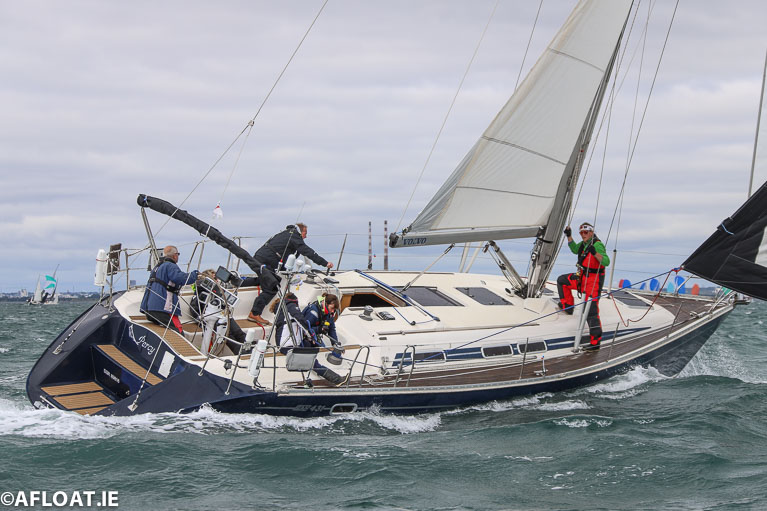 The Elan 431 Percy (John Roberts and Julie Jefferson) from Whitehaven in the UK
The Elan 431 Percy (John Roberts and Julie Jefferson) from Whitehaven in the UK
 Michael O'Leary's Act Two
Michael O'Leary's Act Two
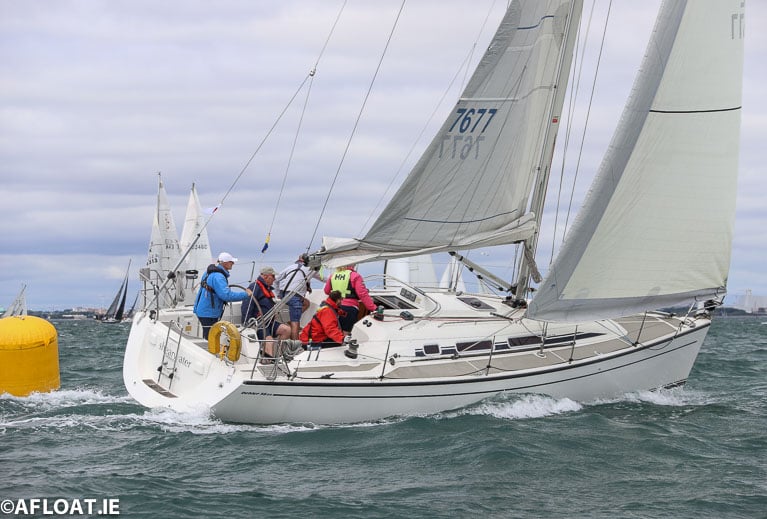 Eamonn Doyle's Royal St George Yacht Club Shearwater, a Dehler 36SQ
Eamonn Doyle's Royal St George Yacht Club Shearwater, a Dehler 36SQ
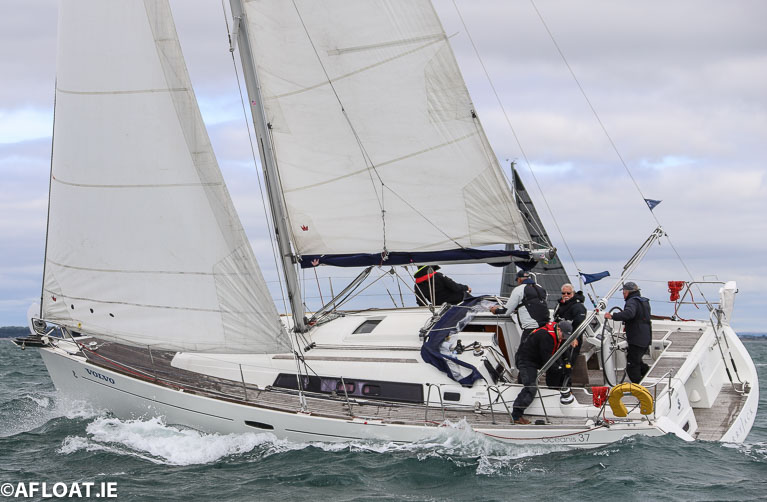 Merryjack, an Oceanis 37 (Gerry & John Bell) from Ballyholme
Merryjack, an Oceanis 37 (Gerry & John Bell) from Ballyholme




























